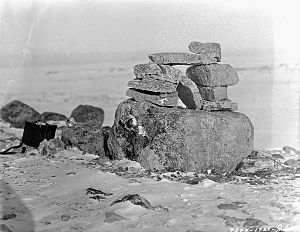J. Dewey Soper facts for kids
Quick facts for kids
J. Dewey Soper
|
|
|---|---|
| Born |
Joseph Dewey Soper
May 5, 1893 Guelph, Ontario, Canada
|
| Died | November 2, 1982 (aged 89) Edmonton, Alberta, Canada
|
| Alma mater | University of Alberta |
| Occupation | Ornithologist, zoologist |
| Spouse(s) | Carolyn Freeman |
Joseph Dewey Soper (born May 5, 1893 – died November 2, 1982) was a famous Canadian explorer, zoologist, and expert on birds (an ornithologist). He traveled a lot in the Canadian Arctic and wrote many books and papers about his discoveries.
Contents
Early Life and Nature
Joseph grew up near Rockwood, Ontario, where he became very interested in animals and nature. His mother hoped he would become a minister, while his father wanted him to work on the family farm. However, Joseph was inspired by famous writers like Henry David Thoreau and Ernest Thompson Seton, who also loved nature.
He went to the University of Alberta to study zoology, which is the study of animals. He even had his first work published when he was just 20 years old!
Exploring the Arctic
First Arctic Journey: 1923
In 1920, Joseph met Dr. R. M. Anderson, who invited him to join a big trip called the Federal Government's East Arctic Expedition. Joseph's job was to record all the plants and animals he found in many Arctic places. These included Baffin Island, Beechey Island, Bylot Island, Devon Island, Ellesmere Island, northern Greenland, and parts of Labrador.
Baffin Island Adventures: 1924–1926
In 1924, the National Museum of Canada hired Soper for another trip to Baffin Island. He set up his main camp at a Royal Canadian Mounted Police base, which was also a Hudson's Bay Company trading post.
During this long journey, Joseph explored many areas, like Nettilling Lake and the Koukdjuak River. He traveled over 4,000 miles (6,400 km) using dog sleds, boats, and canoes!
The Great Blue Goose Search: 1928–1931

One of Soper's biggest achievements was finding the nesting grounds of the blue goose. For six years, he searched Baffin Island, traveling 30,000 miles (50,000 km) with the help of local Inuit people.
In the spring of 1929, he finally found where the blue geese nested! It was on Bluegoose Plain near Bowman Bay. This amazing discovery was even featured in Ripley's Believe It or Not!, and Joseph earned the nickname "Blue Goose Soper."
Working for the Government
In 1934, Soper started working for the Canadian government. He became the first Chief Migratory Bird Officer for the Prairie Provinces. Later, in 1948, he became the Chief Federal Wildlife Officer for Alberta, the Northwest Territories, and Yukon.
By the end of his career, Joseph Dewey Soper had led three major Arctic expeditions. He also wrote more than 130 research papers and articles about his findings. He gave all his personal notes, animal collections, and research materials to the University of Alberta.
Family Life
In 1927, Soper visited his sister in Wetaskiwin, Alberta. There, he met Carolyn ("Carrie") Freeman, who was the first graduate nurse in the Eastern Arctic. They got married, and Joseph often took his wife, and sometimes his young son Roland, on his travels.
Besides being a zoologist and explorer, Joseph also collected Inuit art, like ivory figures, and enjoyed hunting. He passed away in 1982, leaving behind his wife, daughter, son, daughter-in-law, and five grandchildren.
Awards and Special Honors
Joseph Dewey Soper received many awards and honors for his important work:
- 1960: He received an honorary Doctor of Laws degree from the University of Alberta.
- 1978: He was given the Commissioner's Award from the Northwest Territories.
- 1980: He received the Douglas H. Pimlott Conservation Award from Nature Canada.
Several places in the Arctic were also named after him, including:
- The Soper River
- Soper Lake
- The Dewey Soper Migratory Bird Sanctuary, a huge protected area of 3,150 square miles (8,160 km2) on western Baffin Island.
The Alberta Society of Professional Biologists also created the J. Dewey Soper Award, given to Canadian biologists.

